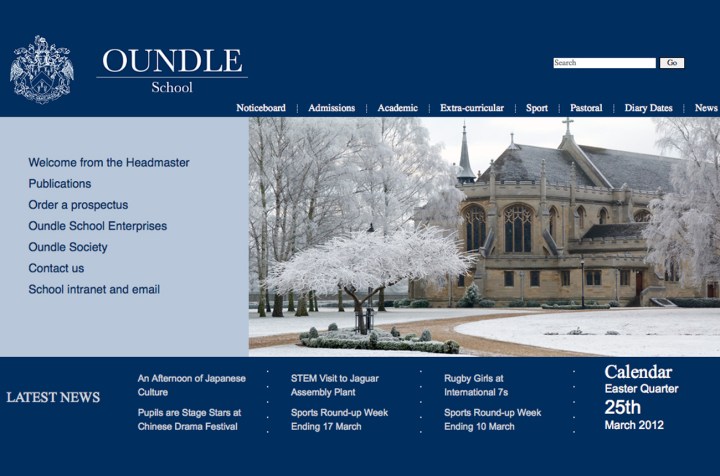Maverick Life, South Africa, World
Different age, different school revolution, same principles

Britain’s Oundle public school was rundown until Frederick William Sanderson arrived as schoolmaster in 1892. Sanderson unlocked libraries, flung open chemistry lab doors and installed state-of-the-art workshops. With a strong focus on science and engineering, Sanderson’s motto was all about openness, taking risks and teaching people what they loved. With Harvard research showing us that great teachers influence the future fortunes of pupils, perhaps changing our country starts with the teachers at our schools? By MANDY DE WAAL.
Unlike most school heads that ensure chemicals, test tubes and books are kept under lock and key, Frederick William Sanderson had a hatred for anything that would keep bright young minds away from discovery.
When Sanderson was the schoolmaster, and later headmaster, of Oundle, a British public school for boys located in Northamptonshire, he flung the doors of the library, workshops and laboratories wide open. He did so because he believed that the boys at Oundle School should be able to explore and learn unfettered, whenever the urge took them.
“I agree with Nietzsche that ‘The secret of a joyful life is to live dangerously.’ A joyful life is an active life — it is not a dull static state of so-called happiness,” Sanderson once said, adding: “Full of the burning fire of enthusiasm, anarchic, revolutionary, energetic, daemonic, Dionysian, filled to overflowing with the terrific urge to create — such is the life of a man who risks safety and happiness for the sake of growth and happiness.”
A school head with a belief in revolution or anarchy would make modern educators balk, but perhaps they should read on to realise the massive rewards that Sanderson’s approach brought about. Not only for the school and its performance, but, more importantly, for the lives of the boys who went to that school.
The impact that Sanderson had on so many is epitomised in this story captured in the book Sanderson of Oundle compiled shortly after the headmaster’s death in 1922, to ensure memories of this remarkable educator wouldn’t dissipate.
“Most enterprising boys I suppose pass through a phase of nocturnal wandering. With me it took the form of wandering down into the library and working in the small hours. There the Head found me at two o’clock one morning,” says a former Oundle School old boy who contributed to the book.
“I suppose he (Sanderson) had been unable to sleep and had got up to wander round. He was astonished and exceedingly angry when he found me, scolded me hotly and made me feel the full gravity of such a breach of discipline. The thunderstorm passed. ‘And what are you reading, my boy, at this hour?’ I told him of the work that had taken possession of me, work for which the day time was all too full. Yes, yes, he understood that. He looked over the notes I had been taking and they set his mind going. He sat down beside me to read them.”
The Oundle School old boy tells of how Sanderson started speaking to him about discovery and the values of discovery. About the incessant fire in humanity to reach out to knowledge and power, and how significant this desire to know was.
“We talked, he talked for nearly an hour in that still nocturnal room. It was one of the greatest, most formative hours in my life,” the old boy says, adding that Sanderson’s last words to him on that evening were: “Go back to bed, my boy. We must find some time for you in the day for this”.
Richard Dawkins writes about Sanderson in his book of essays A Devil’s Chaplain: Reflections on Hope, Lies, Science, and Love, saying: “Sanderson’s passionate desire to give the boys freedom to fulfil themselves would have thrown Health and Safety into a hissy fit, and set today’s lawyers licking their chops with anticipation.”
At schools today, books, Bunsen burners and hacksaws are locked away, unlike at Oundle where during Sanderson’s time an open door policy meant the curious could learn, take risks, discover. Dawkins writes in his essay that the more dangerous chemicals were locked up, “but enough was left about to disturb the equanimity of other masters who had less faith than the head in that providence which looks after the young”.
During that time the boys went in as they pleased, in what was yet another experiment by Sanderson to inculcate trust in the lads. Accidents did happen, but it is the way in which the headmaster dealt with them that is eye opening.
“I was doing some work one day and found myself wanting to hammer a rivet upon something. I found a large surface plate, an extremely accurate and expensive item of equipment, and in my zeal it seemed to me the very thing on which to hammer a rivet,” an old boy relates in Sanderson of Oundle.
“When I had done the surface plate registered my vigour in some appreciative indentations. That did disconcert the Head for a little when it was discovered. But my punishment was quite Oundelian. I had to make a study of the manufacture and use of surface plates and bring a report and explain it all to him. And after that I found I had learnt to look twice at a fine piece of work before I used it ill,” said the old boy.
After the rivet incident and some skylarking enough damage was caused and Sanderson lost faith in the boys for some time, so the doors were again locked except when there was supervisions. But in the spirit of Sanderson the boys were undeterred and used the workshop and library to study locks with great intensity.
In Sanderson of Oundle, another former Sanderson pupil tells of the boys’ escapades: “In our enthusiasm we made skeleton keys for all Oundle, not only for the laboratories but for private rooms as well. For weeks we used the laboratories and workshops as we had grown accustomed to use them, but now with a keen care of the expensive apparatus and with precautions to leave nothing disorderly to betray our visits. It seemed that the head saw nothing; he had a great gift for assuming blindness – until Speech Day came round, and then we were amazed to hear him, as he beamed upon the assembled parents, telling them the whole business, ‘And what do you think my boys have been doing now?'”
When Sanderson first arrived at a run-down Oundle School in 1892 with the directive to revive the institution, it had only 92 boys and was a fairly mediocre place of learning. Unlike local private schools in South Africa, where heads focus on the achievers in order to prove the ROI for expensive education, Sanderson focused on those lads labelled “dull” or average. In local public schools these are the children who mostly get lost in an over-crowded system.
He immediately introduced science and engineering studies to the school when he arrived, and his remarkable workshops didn’t create replicas or models of engines, but the real deal. The boys at Oundle built real, working machines and had the equipment to build vital parts for installation into ships. Because of Sanderson’s bold vision Oundle soon became one of the greatest engineering and science schools in the UK, a reputation it still holds today.
Sanderson, whom science fiction great H. G. Wells called “The greatest Headmaster the world has ever seen”, gave his last speech at a university in London in 1922. It was a hot, muggy day when the stout man with a humorous twinkle in his eye talked passionately about education and held firmly onto the podium in front of him with both hands. He spoke about the grand experiment he had devoted his entire life to, that of creating the greatest and most successful public school in Britain. When he was done, he sat down, slipped from his chair and fell to the floor. He died of heart failure at the age of 66.
Oundle is now irrevocably bound to Sanderson’s name, and vice versa, just as the many old boys whom the legendary man learned under, are what they are today because of their remarkable experience at that school. Great teachers change people’s lives, which is possibly why HG Wells spent much of his later years writing about education and would call Sanderson “the greatest man I have ever known with any degree of intimacy.” HG Wells would also write a short story about Sanderson called: The Story of a Great Schoolmaster.
If there is a real chance of changing or improving a life, it must be in the classroom. This thought is confirmed by research from Harvard and Columbia that shows schoolteachers can impact their students’ future lives and living standards.
“If an elementary school student has an excellent teacher even for a single year, it boosts their income by an average of about 2% per year,” says Raj Chetty a professor of economics at Harvard’s Faculty of Arts and Sciences, who co-authored the study with Harvard Kennedy School’s John Friedman.
The research isolated the long-term impact of what the researchers called “high value-added” teachers, or those educators that did the best job of raising students’ scores on standardised tests. Some 2.5-million children from grades three to eight formed part of the study, which took 20 years to complete.
“We found that students who had an HVA (high value-added) teacher — in the top 5% — for even a single year, not only earned more as an adult, but also were more likely to go to college or to go to a higher-ranked college, and to live in a better neighbourhood,” says Chetty. “They were also less likely to become a teen parent. Across a broad spectrum of measures, they were doing considerably better as the result of having a HVA teacher in elementary school.”
The study’s findings applied to both rich and poor school districts. Research co-author Friedman believes that this could hold the key to turning around underperforming schools and impoverished communities. The research shows that the benefit of a “Sanderson of Oundle” doesn’t end at the school, but could have a knock on effect of changing living standards in poor neighbourhoods.
“We found large effects even for students in poor schools, and for students with poor scores,” says Friedman. “Having a better teacher has roughly the same percentage impact on a student’s future earnings regardless of the quality of the student or income of her parents. For instance, a given teacher might raise earnings by $100 per year for someone who otherwise would earn $10K, but by $400 per year for someone who otherwise would earn $40K. The $400 is more money, but maybe the $100 is more important in terms of household well-being.”
In remembering Sanderson of Oundle and considering what research is showing us about the effect remarkable teachers have on people, it is obvious that schools are a focal point in changing our country. But so far, they have been a point of massive failure in South Africa.
Sibusiso Bengu was this country’s first democratic education minister, and tried to reform the system but he did so with ‘Curriculum 2005’, an educational system based on the now discredited Outcomes-Based Education (OBE) system. What bedevilled the situation further was that the system was installed at schools before teachers could be adequately trained or schools had the resourced to make the OBE system workable.
Kader Asmal was next up and his solution was to integrate schools to address the country’s segregated past. Asmal closed teacher training colleges and his legacy has been both a loss of institutional knowledge at schools, together with a massive shortage of all teachers, never mind just good teachers.
Naledi Pandor, Angie Motshekga and Blade Nzimande have been no better and have all in their own way sown confusion and failure. The most memorable disaster has been the splitting of the ministry into primary and higher education, causing a massive disconnect between the two. Motshekga is well remembered for her statement, “education is not a necessary requirement for leadership”, which was uttered in defence of Julius Malema.
South Africa has an education system that celebrates mediocrity by reducing graduation requirements so that the pass rate for matrics appears to be more politically acceptable. As result, many young people entering universities and the work place don’t have the basic skills required to integrate with any success.
Finally the Democratic Teachers’ Union (Sadtu) has waged a political war with government, and South Africa, at a massive cost to learners. Sadtu has gone on strikes or staged go-slows just as learners have sat to write their final matric exams or in provinces like the Eastern Cape, the most dismal region of them all.
Where is South Africa’s Sanderson? Let’s pray he or she arrives soon because we currently have an education system that’s failing our children, and by so doing, is failing our country and all its people as well. DM
Read more:
- The joy of living dangerously – Forget exams and league tables. Real education, exemplified by a maverick headmaster almost 100 years ago, is about the power of knowledge and the thrill of discovery writes Richard Dawkins in the Guardian.
- Read the full text of Sanderson of Oundle.
Photo: Frederick William Sanderson turned Oundle around. (screengrab of school website)
















 Become an Insider
Become an Insider